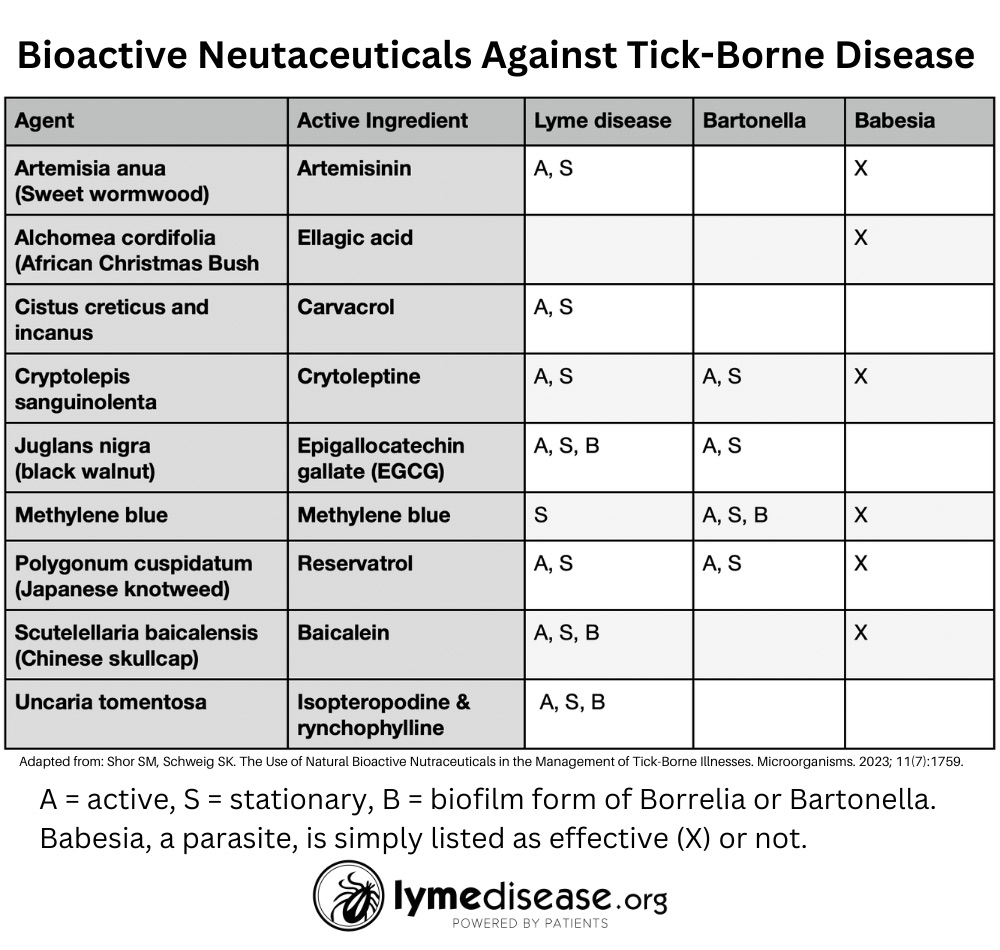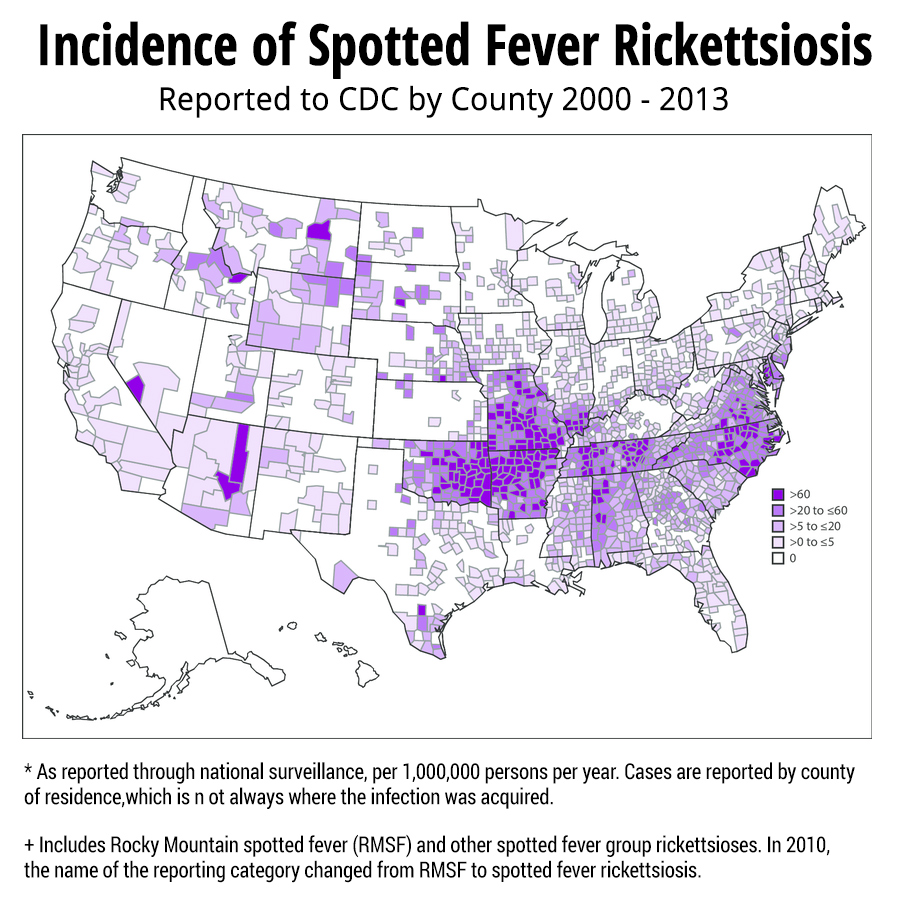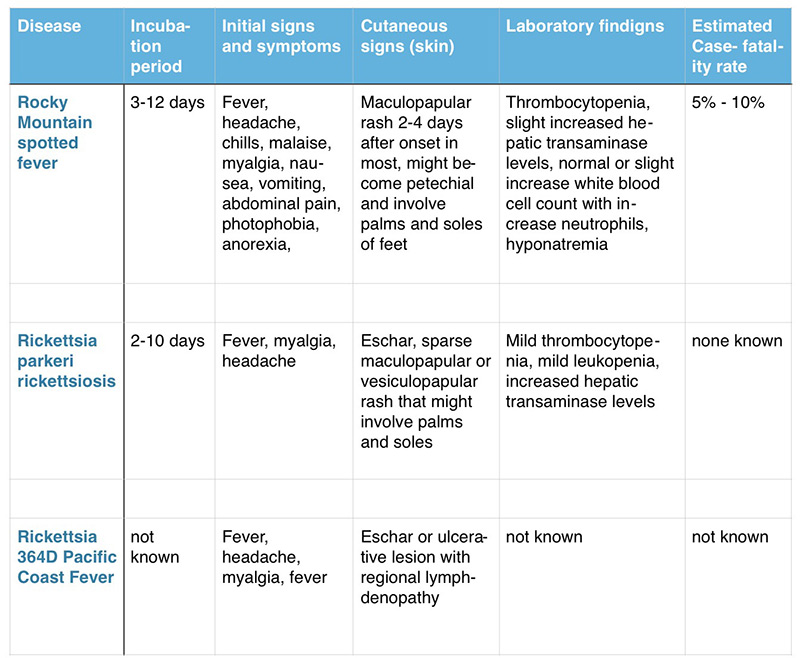Some particularly troublesome bacteria belong to a group called Rickettsia. Although they can also be found in lice, fleas, mites and chiggers, in the US, most rickettsial infections are thought to be transmitted by ticks.
Rickettsia includes two different groups: the spotted fever group (which consists of rickettsiae and ehrlichia) and the typhus group.
The spotted fever group rickettsiae (SFGR) includes:
Rickettsia rickettsii, also known as Rocky Mountain spotted fever (RMSF)
Rickettsia parkeri
Rickettsia philipii, (previously 364D) the cause of Pacific Coast tick fever
Rickettsia helvetica* (which may be found in the U.S.)
*Rickettsia helvetica was discovered by Dr. Willy Burgdorfer in 1978, and widely thought to be found only in Europe. However, it was recently uncovered in Burgdorfer’s 35-year-old archives that he had seen a bacterium that highly resembled R. helvetica inside the samples of blood containing Borrelia (the bacteria that causes Lyme disease). He called this microbe the “Swiss Agent.” (Read more about Rickettsia helvetica discovery.)
Rocky Mountain Spotted Fever
Rocky Mountain spotted fever (RMSF) is the most common rickettsial infection in the U.S. It can range from a mild illness to a fatal one.
Initial symptoms typically include high fever, severe headache, abdominal pain (with or without vomiting), and muscle pain. It often—though not always—includes a spotted rash that begins at the wrist and/or ankles, and spreads outward from there.
The progression of Rocky Mountain Spotted Fever varies greatly between patients. Some may recover quickly on oral medications, while others may require intravenous antibiotics, prolonged hospitalization or intensive care.
RMSF weakens small blood vessels throughout the body, giving rise to its characteristic rash. This widespread damage to the blood vessels allows the bacteria to spread to the heart and brain—and can quickly lead to death in those under age 4, over the age of 60, or those whose immune systems are compromised.
Rickettsia Rash
Prior to the use of antibiotics, Rocky Mountain Spotted Fever had a fatality rate of up to 80%. In the U.S. today, the fatality rate is 5%-10%. However, in neighboring Mexico, fatality rates from RMSF in recent years have been as high as 30%.
Rickettsia In Dogs
An interesting case study occurred in eastern Arizona, where there are no known American dog ticks (the primary vector of RMSF). Beginning in 2003, there were outbreaks of Rocky Mountain Spotted Fever on several Indian reservations, with the rate of infection reaching 150 times the national average, including 19 fatalities. This was later attributed to the large population of free-roaming dogs. Unexpectedly, the brown dog tick was identified as the vector in these cases.
Community leaders and public health officials dramatically reduced the rate of RMSF by treating the yards of 500 homes with acaricide (pesticides which target ticks) and placing long-acting tick collars on over 1000 dogs.
Afterwards, ticks were only found on 1% of the dogs with collars versus 64% of the untreated dogs. These collaborative efforts helped reduce Rocky Mountain Spotted Fever by 43% on the reservations.
Other Types Of Rickettsiosis Infections
Rickettsia parkerii, found along the Gulf Coast, and R. phillipii, from the West Coast, cause a milder form of rickettsiosis. The spotted rash is not as common but both will frequently cause an eschar (scab) or necrotic area about one centimeter across, at the site of the tick bite. These other types of rickettsiosis usually result in a mild illness that may go undiagnosed. Thus, the actual number of infections may be higher than we know.
Rickettsia Transmission
In the United States, Rickettsiosis is primarily transmitted by the following ticks:
- American dog tick (Dermacentor variabilis)
- Rocky Mountain wood tick (Dermacentor andersoni)
- Brown dog tick (Rhipicephalus sanguineus)
- Gulf Coast tick (Amblyomma maculatum)
- Pacific Coast ticks (Dermacentor occidentalis)
Rickettsia Distribution
According to the CDC, rickettsial diseases have been reported in every state except Alaska and Hawaii, where they are not yet notifiable (so nobody is keeping track). 60% of SFGR cases are reported in five states: North Carolina, Oklahoma, Arkansas, Tennessee, and Missouri.
Rickettsia Incidence
In 2009, the reporting definition for Rocky Mountain Spotted Fever was changed to include the more broad “Spotted Fever Rickettsiosis” (SFR) which includes RMSF. Using the new criteria, there were 4470 reported cases of spotted fever rickettsiosis in 2012, the majority of which were presumed to be RMSF. In general, the cases of SFR are increasing–from 1.7 cases per million in 2000 to an all-time high of 14.2 cases per million in 2012.
Summary of Spotted Fever Rickettsiosis Found in U.S.
Learn more about Rickettsia
A middle-aged man died of Rocky Mountain Spotted Fever in Imperial County.
NEWS: Tick-borne RMSF death in Southern California.
Rocky Mountain spotted fever (RMSF) is caused by the bacterium Rickettsia rickettsii and is a cause of potentially fatal human illness in North and South America.
A new kind of tick is causing an epidemic of Rocky Mountain spotted fever in Mexico.
NEWS: Brown dog tick causing RMSF epidemic in Mexico. Spreading to US?
Rocky Mountain spotted fever is already dangerous, and the new carrier is more likely to bite people than the ticks that usually spread it, the team of U.S. and Mexican researchers said.




















